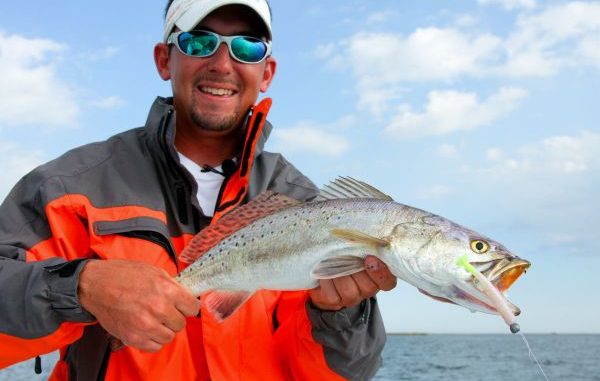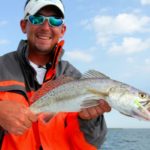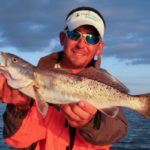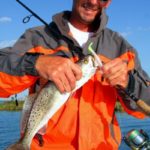
You might be able to catch a bunch of dinks inside the Delacroix marshes, but there’s only one choice if you want to head home with plenty of trout for the freezer — head outside to where the big trout spend their summers.
I can’t tell you how many times I walk through my house during summer to find my kids plopped on the couch Instagramming, Snapchatting, Facebooking or watching plain, old-fashioned television.
“Turn it off and get outside!” I boom as I pass through the living room. “You’re not going to waste your entire summer inside when we have a 3-acre yard, miles of mud trails and our own sandbar on the Bogue Chitto River!”
The problem is that inside is easy.
Inside is comfortable.
Inside is undemanding.
But as much as we might want to stay inside during the summer, the outside is full of unseen riches and untapped rewards that make the effort of going outside worth the trouble.
The funny thing about watching my kids head outside this summer is watching their initial grumbles turn to shouts of joy as they get caught up in just how much fun outside can be.
If I weren’t there to stand over them and demand they go outside, my kids probably wouldn’t catch many speckled trout out of Delacroix this month.
You see, in Delacroix during the summer, the inside might be comfortable, but the outside is where large schools of untapped speckled trout make the effort worthwhile.
Capt. Chris Pike with Cast and Blast Charters (lacastandblast.com or 504-427-4973) has been fishing Delacroix long enough to know that June is when the trout transition from the inside to the outside is complete and the outside bays start heating up.
“Once that full moon in May passes, which will be the last weekend of May and on into the first week of June this year, trout will be where they’re going to be for pretty much the remainder of the summer,” Pike said.
After a spring filled with fishing artificial baits on the inside, Pike said he has to adjust his mentality a little bit once trout hit the big bays.
The first reason is because live bait starts to rules the day.
“I switch almost exclusively to live bait for the trout once they set up outside,” Pike said. “The only exception will be if I come across some birds working shrimp or get into a fast-enough frenzy that I can put the live bait down a little bit and try plastics while they’re fired up.”
The second reason Pike has to adjust his mentality is because trout gang up around structure rather than spreading out across the middle of an open bay, where he might have to drift-fish.
“They’re just a lot more concentrated once they get outside than they ever are on the inside,” said Pike. “They get on those shallow-water rigs in Black Bay and Breton Sound, and then whatever kind of riprap stuff like Iron Banks and oyster reefs and sunken islands — anywhere they can get around bait in deeper and cooler water.”
Whereas Pike might spend a lot of time moving around when trout are inside at Delacroix, once they move outside he can generally hunker down in one or two spots and catch his trout without having to move a lot.
“The whole key with the fish pushing out is you’re just having to go farther to get to the fish because they’re outside during the summer rather than inside,” Pike said.
Launching out of Sweetwater Marina, Pike said he can be on trout at the end of a 15-minute boat ride; however, during June he typically winds up running about 30 to 45 minutes to get into the first zone of outside fish.
That first zone can generally be found in areas like Lake Campo, Bay Lafourche, and Oak River Bay.
“Now, don’t get me wrong: You’ll still have quite a few trout inside, but they’re mostly going to be throwbacks and school trout,” Pike said. “The outside is always going to have the bigger fish during summer, and Lake Campo, Bay Lafourche and Oak River Bay are going that first zone of outside water where summer trout fishing is best.”
This first zone is set apart from the inside because these spots have a lot more oyster reefs, deeper passes and canals that offer the deepwater option close by, as well as being where shrimp empty out as they migrate.
While it might be tempting to consider these three areas as only the first spot trout stop as they move out, Pike said they’ll hold fish all summer long.
“The size will vary each day,” he said. “One day every (trout) will be a keeper, and the next they’ll all be throwbacks, but they are definitely three spots to keep in mind to put some keeper fish in the boat all throughout the summer.”
Once you move past Lake Campo, Bay Lafourche and Oak River Bay, Pike suggested trying Stone Island, Iron Banks, the Wreck, Lonesome Island and Belle Island.
Those stops make up his next zone of outside fishing.
“Out there at those spots, you’re smack dab in the heart of the good, June trout fishing,” Pike said. “After these, you’re looking at the farthest zone, which includes the Black Tanks, Battledore Reef (and) Breton Island, which are all pretty good runs.
“All those spots will hold fish, as well, so it becomes a matter of how far do you have to go.”
Whereas most anglers might consider where they fish based on how close they can find willing trout, Pike said he makes his decision by the direction of the wind and how much river water has been pushed toward Delacroix.
And to make his decision a bit more challenging, Pike explained there are different combinations as to how the river water can invade.
“It can muddy up from the inside out or the outside in,” Pike said, “so we have different combinations as to how the river water can invade.
“I try to watch the wind a couple days in advance of a trip — a west wind is always the worst because it blows right from the river toward Delacroix and Black Bay.”
The first of his favorite spots to muddy up with a west wind are Iron Banks and Stone Island, followed by Belle Island.
Therefore, a few days of west winds means Pike fishes east to west, while a few days of southeast winds allows him to fish west to east.
“The best thing we can hope for is for the river to go down,” he said. “Then we don’t have to fight it nearly as much.”
Although the outside areas around Delacroix can offer some awesome live croaker fishing, Pike said June is strictly a live-shrimp month because the croaker bite doesn’t seem to turn on until later in the summer during July and August.
Shrimp size doesn’t seem to matter, but Pike said he typically fishes with medium-sized shrimp because that is what is generally available at bait stands.
“It’s pretty simple,” Pike said. “I fish live shrimp about 3 feet down under a cork or 10 feet under a sliding cork. The Carolina-rig stuff doesn’t seem to be as effective until late in the summer, as well.”
Pike theorized that bottom fishing with a Carolina rig is better later in the summer because trout tend to go a good bit deeper that time of year, especially when it gets hotter and they move to the deeper rigs in 20 to 25 feet of water.
While doesn’t determine if Pike sits at the dock or goes fishing, he did note that bluebird days with no tide and calm winds definitely can make for some tough fishing.
“Being out in the open water, you don’t want too much wind,” Pike said, “but an overcast day with some light wind is definitely better than bluebird and no wind.
“Anything with the pressure dropping and maybe even a little rain will make the fish eat better.”
It’s also a given that you’ll find yourself fishing around some company if you head outside during June.
But, even if you don’t have the option of fishing only weekdays, Pike said it is possible to beat the crowd.
His first key is trying to do as much homework as you can before you go if you go on a weekend.
“The problem you run into on the weekend is that if you don’t hit (trout) on the first spot, then you’ve got to deal with trying to squeeze in and get a good spot at all the other places,” Pike said.
But if you’re first spot is wrong, Pike said paying attention to the tide and how fast it’s moving can help you catch pressured trout.
“If you’ve got a strong tide out there, the fish will be a lot farther off the structure,” he explained. “With a good tide, you can try to set up a good ways downcurrent of the rig or the structure because the fish will always be farther out on a strong tide.
Pike suggested watching the tide charts at LouisianaSportsman.com to see when Bay Gardene, which will be the most accurate location, and Breton Island show a tidal range over a foot.
Another way to beat the crowd is trying to pull fish to you.
“A lot of these boats will get up close to the structure and throw right at it or a little bit out,” Pike said. “You can fish a different corner of the same rig, and you can try to pull the fish to you by keeping more bait in the water than the other boats have.”
Pike said that, when he’s out there catching fish around other boats, it’s not so much a matter of him being on the right corner of the rig as it is that he has four popping corks going with four live shrimp under them to attract fish.
“Keeping fresh bait on the hook and constant bait in the water pulls those fish to where you are on the rig,” he said.
Outside during June, Pike said the average trout is 1 ½ pounds, with a big trout being 4 pounds or better.
Heading outside at Delacroix this month means you’re going to have to get out of your comfort zone. Staying inside might be easy, but if you want to reap the rewards of what the outside has to offer, you’re going to have to make an effort.
Then you’ll actually have something worth Instagramming, Snapchatting or Facebooking.


